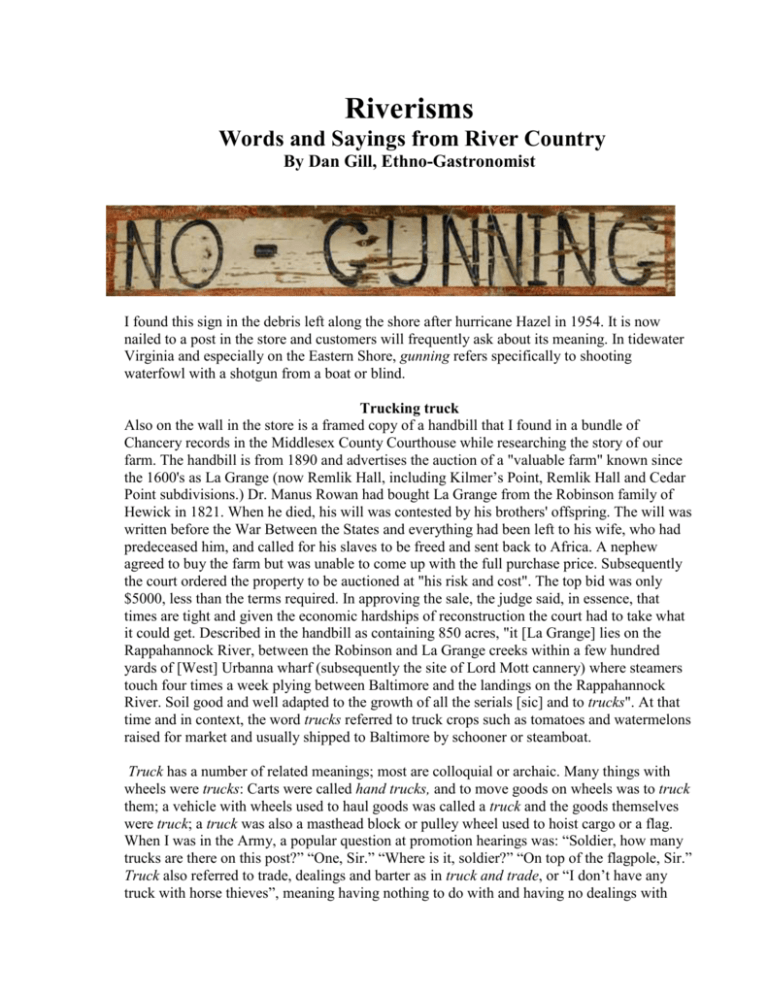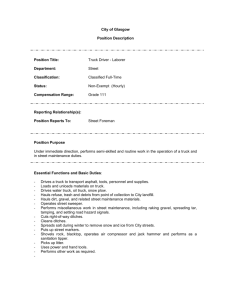Words and sayings - Something Different
advertisement

Riverisms Words and Sayings from River Country By Dan Gill, Ethno-Gastronomist I found this sign in the debris left along the shore after hurricane Hazel in 1954. It is now nailed to a post in the store and customers will frequently ask about its meaning. In tidewater Virginia and especially on the Eastern Shore, gunning refers specifically to shooting waterfowl with a shotgun from a boat or blind. Trucking truck Also on the wall in the store is a framed copy of a handbill that I found in a bundle of Chancery records in the Middlesex County Courthouse while researching the story of our farm. The handbill is from 1890 and advertises the auction of a "valuable farm" known since the 1600's as La Grange (now Remlik Hall, including Kilmer’s Point, Remlik Hall and Cedar Point subdivisions.) Dr. Manus Rowan had bought La Grange from the Robinson family of Hewick in 1821. When he died, his will was contested by his brothers' offspring. The will was written before the War Between the States and everything had been left to his wife, who had predeceased him, and called for his slaves to be freed and sent back to Africa. A nephew agreed to buy the farm but was unable to come up with the full purchase price. Subsequently the court ordered the property to be auctioned at "his risk and cost". The top bid was only $5000, less than the terms required. In approving the sale, the judge said, in essence, that times are tight and given the economic hardships of reconstruction the court had to take what it could get. Described in the handbill as containing 850 acres, "it [La Grange] lies on the Rappahannock River, between the Robinson and La Grange creeks within a few hundred yards of [West] Urbanna wharf (subsequently the site of Lord Mott cannery) where steamers touch four times a week plying between Baltimore and the landings on the Rappahannock River. Soil good and well adapted to the growth of all the serials [sic] and to trucks". At that time and in context, the word trucks referred to truck crops such as tomatoes and watermelons raised for market and usually shipped to Baltimore by schooner or steamboat. Truck has a number of related meanings; most are colloquial or archaic. Many things with wheels were trucks: Carts were called hand trucks, and to move goods on wheels was to truck them; a vehicle with wheels used to haul goods was called a truck and the goods themselves were truck; a truck was also a masthead block or pulley wheel used to hoist cargo or a flag. When I was in the Army, a popular question at promotion hearings was: “Soldier, how many trucks are there on this post?” “One, Sir.” “Where is it, soldier?” “On top of the flagpole, Sir.” Truck also referred to trade, dealings and barter as in truck and trade, or “I don’t have any truck with horse thieves”, meaning having nothing to do with and having no dealings with horse thieves. Prior to WWII, truck farmers in the Middle Peninsula and Northern Neck had little or no truck with the Richmond markets because it was too difficult to truck truck in trucks over the rough roads and across rivers. In those days it was much easier to put produce on a boat and ship it to Baltimore. Watermelons, cantaloupes, cucumbers, corn, tomatoes, sweet potatoes and English peas were popular truck crops and a canning industry evolved to process them locally. Scores of canneries, on both sides of the Rappahannock River, processed tomatoes and English peas. Lord Mott, for example, was built on the remnants of West Urbanna Wharf after the hurricane of ’33 ended the steamboat era, and canned tomatoes and English peas until the cannery was bought by Campbell’s Soups, and then canned oyster stew into the 1970’s. I remember riding the school bus to Urbanna Elementary School and passing huge, odoriferous mounds of rotting pea hulls on Lord Mott road. The devil to pay Sailing ships were made of wooden planks fastened to a framework of ribs with wooden pegs. The seams between the planks were packed with cotton or oakum and coated with hot pitch called pay to make them watertight. As the planks moved and worked in rough seas, seams could open, lose their caulking and place the ship in jeopardy of sinking. The most critical seam in a planked vessel is known as the devil seam, which is right at or below the waterline at the turn of the bilge where the sides and bottom join. This is the area of maximum curvature that must absorb much of the stress and movement and is the most likely seam to fail in heavy seas. If near land, a ship could be beached and careened on her side for the bottom seams to be caulked, but if at sea, the leaks had to be stopped while under way. The ship was heeled over as far as possible and a sailor, equipped with a mallet, caulking iron, oakum and hot pitch, was lowered over the side in a bosun’s chair to pay the seams – a risky business in rough waters. If the wind slacked or changed direction, the vessel could right and the sailor would find himself between the devil and the deep blue sea. I like this version of the story, but was informed by a Naval Architect that it is highly unlikely, if not physically impossible, for period sailing ships to be heeled over far enough to pay the devil from the outside while at sea and that the term probably evolved because paying seams, even from the inside, was an unpleasant and arduous task. Now-a-days the term implies having to face or deal with dire consequences, usually the result of ones own actions. To pay the devil also implies urgency lest the ship sinks. To have the devil to pay and no pitch hot means that the situation is hopeless, as pitch comes in solid blocks and takes a long time to melt. Balls to the wall Though not necessarily local, balls to the wall is used (and mis-used) locally. Contrary to popular belief, the term is not crude and has nothing to do with anatomy. One popular derivation is from aircraft pilots in WWII. The throttle levers had balls on the end and when a pilot pushed the throttles all of the way forward until stopped by the firewall, as in taking off or dog-fighting, he was said to be going “balls to the wall”. In support of this theory, the term did not appear in print until the late 1940’s. I prefer to think that it is much older. During steamboat and railroad times, steam and diesel engines had a governor consisting of two weighted metal balls mounted on the ends of hinged rods and linked to a governor valve. As engine RPMs increased, centrifugal force spun the balls outwards actuating the valve and thus regulating speed. If the throttle was opened fully, overriding the governor, the balls could spin so fast that they were horizontal and could brush the surrounding walls, particularly in a ship. John Luther Jones was an engineer on the Illinois Central Railroad who had a reputation for arriving on time. As a young fireman, he was given the nickname ‘Cayce’, after his hometown in Kentucky, by a brakeman while visiting a boarding house on the mainline. On April 30,1900, Cayce was trying to make up time and was running balls to the wall when, through the fog, he saw the red lantern of a freight train on the tracks ahead. He told his fireman to jump while he desperately and heroically tried to slow the train. No passengers were killed, but Cayce was found dead in the mangled cab. Watermen Watermen are a hearty and independent breed who work the waters of the Chesapeake Bay and its tributaries. The terms waterman and watermen are specific only to the Chesapeake Bay region and the Thames River area in England; elsewhere they are just fishermen, lobstermen or crabbers. Watermen, and especially those from Tangier Island and the Guinea Marshes who still speak a form of Cornish or Elizabethan English, have a lot of picturesque and unique sayings because of their working perspective of tides, winds and nature. When the wind is out of the nor’east and the marshes are covered with water up to the tree line, some watermen will observe that, “The ‘toyeid’ [tide] she’s a-makin’ up in the woods”. The late James F. “Lighthouse” Crocket was one of many refugees from Tangier Island who moved to the mainland after the hurricane of ’33 swept over the island. As a boy, he was nicknamed “Lighthouse” by the Islanders because his flaming red hair made him stand out like a lighthouse. One morning Lighthouse was sitting on his boat when Bob French, a local yachtsman with skinny legs, strolled down the dock wearing shorts. Lighthouse looked up and said, “Capt’n Bob, you looks like a crane a-standin’ on a mudflat.” In referring to Bob’s yacht, which was big and slow, Lighthouse observed that, “she don’t draw as much wake as a soft crab.” Northern Neckisms Natives of the Northern Neck of Virginia still use a number of unusual and colorful expressions that are remnants of their Middle English heritage. Though born and raised on the south side of the Rappahannock River, I heard the following words and terms from my father while I was growing up. Daddy was born in Northumberland County on top of Hard Bargain Hill in Ball’s Neck (pronounced nake) and claimed to have driven a hard bargain ever since. He came along at the end of the horse-and-buggy era, when people told stories and had real conversations, as there was little else to do for entertainment. To bell a buzzard: Buzzards can be a serious nuisance in the country, especially if you have livestock. They can actually kill vulnerable newborn calves and pigs unless aggressively chased away. To bell not only means to ring a bell but also to yell or bellow or otherwise raise a commotion. Therefore, someone who doesn’t have sense enough to bell a buzzard fails to comprehend the consequences of a situation and take appropriate action. Mommick: Mommick, with many dialectic variations in spelling, pronunciation and usage, evolved from Old English and has survived in some local American dialects, especially along the coasts of Virginia and North Carolina. As used in the Northern Neck and as I heard it from my father, it means to break into pieces, tear up, put in disarray or otherwise make a mess of. “She tried to decorate the birthday cake, but mommicked it up something terrible.” As stubborn as a mollified mule: To mollify means to soothe, soften or quiet. A mollified mule will just look at you as if to say, “Yeah, right – you pull the plow and I’ll just watch!” In a sweat and a swivet: Sweat and Swivet both mean essentially the same thing in Old English: in a hurry or in a state of excitement or anxiety. They are usually used separately, as “in a swivet” or “don’t sweat it”, but Northern Neckers put them together in this quaint phrase that I often heard from my father. “He was in a sweat and as swivet because his tractor broke down and he still had hay in the field.” ‘Deed so and ‘deed ‘tiz: These contracted forms of “indeed it is so” and “indeed it is” are prevalent in the Northern Neck, but seldom encountered elsewhere. I have heard whole conversations carried on with just an occasional subject, verb and direct object or two thrown in for continuity. ‘Deed so. There are many more colorful and interesting words and sayings that were once popular in the Northern Neck, Middle Peninsula, Bay Islands and Eastern Shore of Virginia, but are now being lost because of the homogenization of society. ‘Deed so. These are just some of my favorites that I have heard since childhood. I hereby challenge the readership to send their interesting words and phrases to Pleasant Living, especially those peculiar to River Country. If we get enough participation, we might compile a dictionary of “Riverisms”. © Dan Gill - Published in Pleasant Living July – August ’10 Something Different Country Store and Deli www.pine3.info






